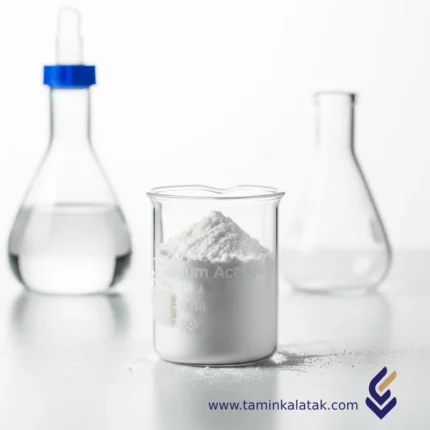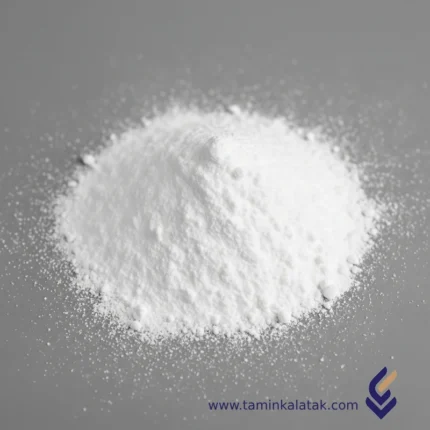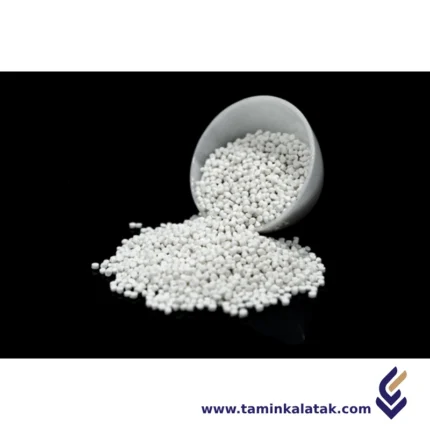Calcium acetate
Sodium Acetate (CH₃COONa) is the sodium salt of acetic acid. It appears as a white crystalline powder, either odorless or with a faint vinegar-like smell (especially when heated). Sodium acetate is slightly hygroscopic, particularly in its anhydrous form, and exists in two common forms:
-
Anhydrous (dry) sodium acetate, and
-
Hydrated sodium acetate, typically the trihydrate form (CH₃COONa·3H₂O).
Chemical Structure of Sodium Acetate
Sodium acetate is an ionic compound composed of a sodium cation (Na⁺) and an acetate anion (CH₃COO⁻).
The acetate ion contains a methyl group (CH₃) bonded to a carboxylate group (COO⁻). Within the carboxylate group, the double bond between carbon and oxygen exhibits resonance, meaning the negative charge is delocalized over both oxygen atoms.
Chemical formula: CH₃COONa
Resonance structure: O=C–O⁻ ↔ ⁻O–C=O
Properties of Sodium Acetate
| Property | Description |
|---|---|
| Appearance | White crystalline powder |
| Odor | Odorless; may emit a vinegar-like smell when heated |
| Solubility | Highly soluble in water; slightly soluble in ethanol (~1.4 g/100 mL) |
| Hygroscopicity | The anhydrous form absorbs moisture from air |
| pH Nature | A salt of a weak acid (acetic acid) and a strong base (NaOH); aqueous solutions are slightly basic (pH 8–9 for 0.1 M solution) |
| Melting Point | Anhydrous: decomposes around 324°C; Trihydrate: melts at ~58°C, releasing its water of crystallization |
| Buffer Capacity | Forms a buffer with acetic acid, effective in pH range 4.0–6.5 |
| Chemical Behavior | Can release acetic acid or CO₂ upon contact with strong acids or oxidizing agents |
Applications of Sodium Acetate
1. Food Industry
-
Used as a food additive (E262) for pH control, flavoring (salty/sour), and preservation.
-
Exhibits antibacterial and antifungal properties in certain food formulations.
2. Pharmaceutical and Medical Applications
-
Used as a source of sodium in IV infusions and dialysis solutions.
-
Functions as a buffering agent in pharmaceutical formulations and biological reactions.
3. Textile Industry
-
Serves as a dyeing assistant and pH regulator in dye baths.
-
Neutralizes residual acids such as sulfuric acid (H₂SO₄).
-
Helps prevent static electricity on fabrics.
4. Construction Industry
-
Used as an additive in concrete to control pH and improve frost resistance (acts as a sealing agent).
5. Laboratory Applications
-
Widely used in buffer preparation (especially in biochemistry and DNA extraction).
-
Acts as a carbon source for bacterial cultures.
-
Included in extraction and purification solutions in molecular biology.
6. Hand Warmers and Heat Packs
-
In supersaturated sodium acetate trihydrate solutions, rapid crystallization releases latent heat (approximately 264–289 kJ/kg)—used in reusable heating pads.
7. Other Industrial Uses
-
Rubber industry: delays vulcanization of chloroprene.
-
Leather tanning and dye production: acts as a process regulator.
Advantages of Sodium Acetate
✅ FDA-approved as safe for food use (within regulated limits)
✅ Effective buffering properties
✅ High compatibility with industrial processes
✅ Low cost and readily available
✅ Exhibits antimicrobial and preservative effects
✅ Useful in phase-change thermal systems
Disadvantages of Sodium Acetate
⚠️ Hygroscopic (especially the anhydrous form) — requires sealed storage
⚠️ Irritating to eyes and skin upon contact
⚠️ Inhalation of dust may cause respiratory irritation
⚠️ Ingestion in excess may lead to gastrointestinal discomfort or hypernatremia
⚠️ Decomposes at high temperatures, releasing irritating vapors
⚠️ Should be used with caution in renal or cardiac patients due to electrolyte effects
⚠️ Some pharmaceutical forms may contain aluminum or other excipients, requiring special care in premature infants or renal patients
Calcium diacetate
Calcium Diacetate is a chemical compound with the formula Ca(CH₃COO)₂. It is found as a white crystalline powder and is usually odorless or has a faint vinegar-like smell. Other names include calcium acetate and calcium ethanoate. The anhydrous form is very hygroscopic, so it is commonly supplied as the monohydrate (Ca(CH₃COO)₂·H₂O).
Structure of Calcium Diacetate
A molecule of calcium diacetate consists of one Ca²⁺ cation and two acetate anions (CH₃COO⁻). The calcium ion serves as the central cation, ionically bonded to two negatively charged acetate groups. Its crystalline structure varies depending on hydration.
Key Properties of Calcium Diacetate
-
Appearance: White crystalline powder
-
Odor: Generally odorless, or faint vinegar smell
-
Solubility: Freely soluble in water; slightly soluble in methanol; insoluble in acetone, ethanol, and benzene
-
Molar Mass: Approximately 158.17 g/mol (anhydrous)
-
Melting/Decomposition Point: Decomposes around 160 °C
-
Density: About 1.509 g/cm³
-
pH of Aqueous Solution: Neutral to slightly alkaline (pH ~6.3–9.6 for 10% solutions)
-
Hygroscopicity: The anhydrous form strongly absorbs moisture
Advantages of Calcium Diacetate
-
Source of Calcium: Used in dietary and pharmaceutical supplements
-
Food Preservative: Added under E263, inhibits mold growth and extends shelf life of baked goods
-
pH Regulator: Acts as a buffering agent in food processing
-
Stabilizer: Used in textile dyeing for color fixation and in food like canned vegetables and tofu to improve texture
-
Generally Recognized as Safe: Considered non-toxic at permitted levels
-
Good Water Solubility: Facilitates incorporation in various formulations
Disadvantages of Calcium Diacetate
-
Digestive Side Effects: Overconsumption or sensitivity may cause mild GI symptoms like bloating, constipation, or gas
-
Hygroscopic Nature: Needs dry storage to prevent moisture absorption
-
Drug Interactions: May interfere with absorption of certain medications—consultation advised when taken concurrently
-
Risk of Hypercalcemia: Excessive intake can raise blood calcium levels, leading to related health risks
Applications of Calcium Diacetate
Food Industry:
-
Preservative (anti-mold) in breads, pastries, and other baked goods
-
pH regulator and buffer
-
Stabilizer/firming agent in foods such as tofu (as a preferred alternative to calcium sulfate) and canned vegetables
-
Ingredient in candies, desserts, puddings
-
Additive in animal feed
Pharmaceutical Sector:
-
Buffering agent in medicinal formulations
-
Calcium supplement for deficiency
-
Phosphate binder for dialysis patients with high blood phosphate
Textile Industry:
-
Used as a color fixer
Chemical Industry:
-
Catalyst in select chemical reactions
-
Previously used in acetone production
Wastewater Treatment:
-
Employed to remove phosphate from wastewater
Soap Production:
-
Utilized as an alkali in certain soap manufacturing
Fire Gel Production:
-
When dissolved in alcohol at saturation, it forms a semi-solid, combustible gel suitable for flame use
Calcium Hydrogen Phosphate Dihydrate
Properties of Calcium Hydrogen Phosphate DihydrateLow solubility in water: It dissolves slightly in cold water. Source of calcium and phosphorus: It contains a large amount of calcium and phosphorus, which are essential for the body. Buffering property: It can reduce pH changes in solutions. Odorless and tasteless: It has no specific odor or taste. Thermal stability: It is stable up to high temperatures.
Applications of Calcium Hydrogen Phosphate DihydrateFood industry: Food supplement: It is used as a source of calcium and phosphorus in food supplements and fortified foods. Fortifying agent: It is used to strengthen bones and teeth in food products. pH regulator: Used to adjust pH in some food products. Pharmaceutical industry: Antacids: Used as an antacid agent in antacids. Calcium supplements: Used to treat calcium deficiency. Agricultural industry: Fertilizer: Used as a source of phosphorus in agricultural fertilizers. Animal feed: Used as a nutritional supplement in animal feed. Dental industry: Toothpaste: Used as a mild abrasive in toothpaste. Other industries: Plastics industry: Used as a filler in some plastic products. Ceramic industry: Used as a raw material in the production of ceramics.
Benefits of using Calcium Hydrogen Phosphate DihydrateRich source of calcium and phosphorus: Essential for healthy bones and teeth. Safe and non-toxic: Does not pose a health risk if used correctly. Affordable: More affordable than other sources of calcium and phosphorus. Wide applications: Used in various industries.
Calcium Ligno Sulfonate
Properties of calcium lignosulfonateGood dispersibility: disperses particles in water and ensures uniform mixing. Adhesion: adheres to different particles and creates bonds between them. Emulsifying: can create stable emulsions of oil in water or water in oil. Reducing surface tension: Reduces the surface tension of water and improves the dispersion of materials. Environmental compatibility: Obtained from natural resources and biodegradable.
Applications of Calcium Lignosulfonate
- Plaster Board
- Activated carbon
- Carbon Black
- Ceramics
- Resins PF
- Soil stabilization
- Tanning
- Pigments
- Chemicals
- Fertilizers
- Dyestuff
- Concrete
Calcium Lingosulfanate
Calcium Lignosulfonate ApplicationsAgricultural Industry: Fertilizer: Acts as a soil improver and increases the absorption of water and nutrients by plants. Anti-salinity: Helps reduce the effects of soil salinity. Construction Industry: Concrete Additive: Used as a lubricant and water reducer in concrete. Binding Agents: Used in the production of building materials such as cement blocks. Food Industry: Color Fixer: Used in the food industry to stabilize the color of some foods. Antifoam: Used in the food industry to reduce foaming of foods. Other Industries: Leather Industry: Used as a tanning agent. Textile Industry: Used as a softener and antistatic agent.
Calcium Nitrate
Properties Calcium NitrateAppearance: White, odorless solid Chemical formula: Ca(NO3)2 Solubility: Easily soluble in water Compound type: Ionic compound
Applications Calcium NitrateAgriculture: Nitrogen fertilizer: As a source of nitrogen and calcium for plants, it promotes faster and healthier growth. Soil improvement: Helps improve soil quality and structure and prevents soil erosion. Chemical industry: Production of dyes and pigments: Used as a raw material in the production of dyes and pigments. Explosives Production: Used as an oxidizing agent in the production of explosives. Food Industry: Food Preservative: Used as a preservative in some foods.
BenefitsIncreases plant growth: The nitrogen in calcium nitrate increases plant growth and development. Prevents soil erosion: Calcium nitrate helps improve soil structure and prevent erosion. Source of Calcium: This compound is a rich source of calcium, which is essential for plant growth.
Calcium Polyphosphate
Properties of Calcium PolyphosphateLow solubility in water: It dissolves slightly in cold water. Source of calcium and phosphorus: Contains a large amount of calcium and phosphorus, which are essential for the body. Dispersion property: It has good dispersion property due to its special molecular structure. Thermal stability: It is stable up to high temperatures. Adhesion property: It is used as an adhesive in some applications.
Applications of Calcium PolyphosphateFood industry: Anti-caking agent: It is used to prevent particles from sticking together in powders and granules. Stabilizing agent: It is used to stabilize emulsions and suspensions. Texture improving agent: It is used to improve the texture and structure of food products. Pharmaceutical industry: Drug carrier: Used as a drug carrier in some formulations. Anti-caking agent: Used to prevent tablets and capsules from sticking together. Agricultural industry: Fertilizer: Used as a source of phosphorus in agricultural fertilizers. Animal feed: Used as a nutritional supplement in animal feed. Other industries: Textile industry: Used as a softening and anti-wrinkle agent in the textile industry. Paper industry: Used as an agent to improve the quality of paper.
Benefits of using calcium polyphosphateRich source of calcium and phosphorus: Essential for healthy bones and teeth. Safe and non-toxic: Does not pose a health risk if used correctly. Wide applications: Used in various industries. High dispersibility: Improves the quality of products.
Caprolactam (CPL)
Car (PCR) Tires
Carbon Black
Applications of Carbon Black
- Tires
- Plastics and Rubber
- Electronics
- Radar Absorbent Materials
Carbonate Masterbatch
Structure
The structure of carbonate masterbatch consists of finely ground calcium carbonate (CaCO₃) particles dispersed in a polymer carrier resin, such as polyethylene (PE), polypropylene (PP), or other thermoplastics. The calcium carbonate acts as a functional filler, providing improved mechanical properties, cost reduction, and enhanced processability. To ensure uniform dispersion and compatibility with the base polymer, the CaCO₃ particles are often coated with surface modifiers or coupling agents, such as stearic acid, which enhances their bonding with the polymer matrix. The polymer carrier resin serves as a medium to evenly distribute the calcium carbonate during processing, preventing agglomeration and ensuring consistent performance in the final product. The proportion of CaCO₃ in the masterbatch can vary depending on the intended application, typically ranging from 20% to 80%. This structure allows for improved stiffness, thermal stability, and opacity while maintaining the flexibility and processability of the plastic.Properties
Carbonate masterbatch possesses several key properties that make it a valuable additive in plastic production. It has high dispersion, ensuring uniform distribution of calcium carbonate within the polymer matrix, which enhances the mechanical properties of the final product. The masterbatch improves stiffness, rigidity, and impact strength while maintaining sufficient flexibility for various applications. It also enhances thermal stability, allowing plastic materials to withstand higher processing temperatures without degradation. Due to the presence of calcium carbonate, it increases opacity and whiteness, which is particularly beneficial for films, sheets, and molded products. The masterbatch helps in cost reduction by replacing a portion of expensive polymer resin with a more affordable filler without compromising product quality. Additionally, it improves processability by enhancing extrusion and molding performance, reducing shrinkage, and providing better dimensional stability. Its density varies depending on the calcium carbonate concentration, typically ranging from 1.5 to 2.2 g/cm³, and it has a melt flow index (MFI) tailored to match the base polymer for seamless integration into manufacturing processes.Applications
- Used in plastic films such as shopping bags, garbage bags, and agricultural films to enhance opacity and reduce costs.
- Applied in injection molding for household products, containers, and automotive components to improve strength and stiffness.
- Utilized in blow molding for producing bottles and hollow plastic items with better rigidity.
- Incorporated in extruded sheets, pipes, and profiles to enhance mechanical properties and processing efficiency.
- Used in non-woven fabrics to improve stiffness and provide a better hand feel for hygiene products.
- Applied in thermoforming to manufacture rigid packaging trays and disposable containers.
Advantages
- Reduces production costs by replacing expensive polymer resins with calcium carbonate.
- Improves mechanical properties, such as stiffness, impact resistance, and dimensional stability.
- Enhances processability by improving extrusion, injection, and blow molding performance.
- Increases opacity and whiteness, reducing the need for additional whitening agents.
- Provides thermal stability, allowing for high-temperature processing without degradation.
- Reduces shrinkage and warping, leading to better-finished products.
- Eco-friendly as it reduces polymer consumption and can improve recyclability in some applications.
Disadvantages
- Higher filler content may reduce flexibility, making some plastic products more brittle.
- May affect transparency, making it unsuitable for clear plastic applications.
- Can alter surface properties, potentially impacting printability or adhesion in certain cases.
- May require surface treatment for better compatibility with some polymer matrices.
- Increased density can add weight to the final product, which may be undesirable in lightweight applications.










